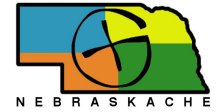In the meadow country of Sheridan County, where numerous springs are found, the Village of Hay Springs formed its legal government on December 4, 1885. Five local residents were named as trustees by the county commissioners.
J.E. Brown, first editor and publisher of "The Hay Springs News", related his impression of the town...."Hay Springs was a nondescript collection of tents and shanties put up temporarily along both sides [of the road], just east of the well and the section houses. The buildings had been hastily thrown together and were ornamented by home-made signs telling the world what their stock in trade was. I counted five saloons in sight as I sat on my wagon and also noticed several groceries, a furniture store, eating houses, and the like..."
Brown continues... "grade work on the railroad was completed almost to Chadron and the rails were being laid through Hay Springs. Most of the land was filled as far south as the river with two families actually living on each section. The sidewalks of the town were not wide enough to accommodate the crowds on Saturdays."
Postal facilities were also moved from Moakler, three miles west, to Hay Springs in 1885. At that time the town was so full that people were selling sleeping space on floors, counters, and in tents. Things were very optimistic and hopeful. Some had only enough money to make it to the area while others had funds to start their operations and to stay a year. Therefore, many of the early settlers relocated to other areas.
Hay Springs attempted to be named the county seat but because of its extreme western location, the influence of the railroad, and some "questionable balloting," the designation was given to another city. Hard feelings by the citizens of the two towns almost caused a division into two long, narrow counties. The topic was not a safe one for discussion for a long time.
Hay Springs is known for the 'Monster of Walgren Lake.' In 1892 there were two lakes in close proximity, about four miles southeast of town, called the East Lake and the West Lake. A ditch between the lakes was cut, four to six feet deep using scrapers and shovels, to drain over 160 acres of land and freshen the East Lake water to be habitable for fish. Businessmen from Hay Springs and the State of Nebraska purchased frontage acres and secured the water rights through an adjoining quarter of land in 1925. Later, the state also purchased Alkali Lake -- now known as Walgren Lake -- and developed it into a recreation site.
The story is told that, in 1923, Arthur Johansen and his team were "scared into a frenzy by a piteous creature" as a result of the "noise from its proboscis and spouting water." (El Paso Times, Texas) During the Hay Springs centennial celebration, area residents visited Walgren Lake to again catch sight of the "monster".
Hay Springs had gold fever too! In February 1902, a mining corporation was organized. An article appeared claiming ..."a pan brigade has been busy washing for several days and good 'color' is reported."
Farsighted residents believed progress would create growth in the area. In 1900 a central telephone office was installed in Hay Springs. Kerosene lamps were put aside in 1912 when T.J.Guthrie installed the first electric and light plant. Roma Reno traded his farm to Guthrie for the plant and operated it until REA came to the area. A hospital was established by Dr. Stanley Clements in the Koehnke Hotel in 1913. State Highway 20 was surveyed through Hay Springs in 1917 (originally known as the Lincoln Highway Road) opening the way for travel and tourism.
History by Selma Kudrna, gleaned from Virtual Nebraska.
You will find yourself at the south edge of this town and there is ample parking with even room for RV's. The area is publicly accessible, but it can be super busy at times. You do not need to open anything or step inside the flower bed. Respect the area, CITO if needed, practice extreme stealth, and rehide the cache as you find it so the next person can have the same challenge. Thank you and good luck.
Congratulations "KiltedKurmudgeon" : First to Find - September 17, 2012

